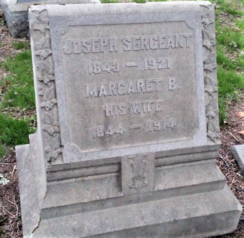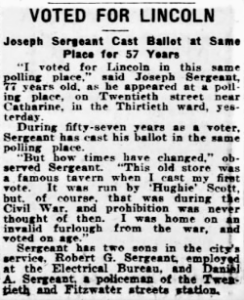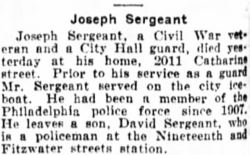Title: Army Sergeant, Civil War; police officer
Birthdate: March 5, 1843
Death Date: September 4, 1921
Plot Location: Section 129, Lot 52

The Sergeants may have originally used the name Sargent when they lived in Ireland and had six or seven children. After the parents settled in Newark, Delaware in the mid-1850s, two of their grown children remained there the rest of their lives and the others became residents of Philadelphia.
Joseph had only been in this country five years when the southern states seceded from the Union. He signed up with Company I of the 88th Pennsylvania Volunteer Infantry on September 18, 1861. Less than three months later he was promoted to sergeant and transferred to Company K of the 88th. For the rest of his three and a half years of service he was the soldier whose name was the same as his rank.
It was on September 17, 1862 during the Battle of Antietam that Joseph was shot in the chest. The iron ball carried pieces of his woolen blanket into the wound. For eight days he lingered between life and death at the field hospital until he was sent to Washington. Surgeons there removed the wool fragments but the ball remained in his chest the rest of his life.
The sergeant returned to his company at some point. Most likely it was after the bloodshed at Gettysburg in July of 1863, but it could have been as late as April 7, 1964 when the regiment returned from a 60-day furlough. At that point the 88th went into the Battle of the Wilderness, and then to Spotsylvania Court House where he was wounded again, this time in the thigh. He remained on active duty and was discharged on June 30, 1865.
(Two others who served in the 88th are also here at Mount Moriah: Captain Sylvester Martin was wounded at the Battle of Antietam, and Private Thomas Davidson was killed at the Second Battle of Bull Run.)
While on that furlough in 1864, the sergeant  married Margaret “Maggie” Armstrong, and Joseph Jr. was born nine months later, on January 8, 1865. They settled in the 2000 block of Catharine Street where family members lived for the next 50 years. This news clipping from 1920 says he first voted in 1864 when the newlyweds lived on that same block.
married Margaret “Maggie” Armstrong, and Joseph Jr. was born nine months later, on January 8, 1865. They settled in the 2000 block of Catharine Street where family members lived for the next 50 years. This news clipping from 1920 says he first voted in 1864 when the newlyweds lived on that same block.
Over the years Joseph was a plasterer, a skill picked up by two of his sons. Demand for his work was variable, so he worked as a night watchman from time to time. He also held the seasonal job of boatman on one of the city’s three iceboats. The Bureau of Ice Boats was in operation from 1837-1907 “to ensure a free and open passage on the river to the Port of Philadelphia.”
 Outside of work he was active in the U.S. Grant Post #5 of the Grand Army of the Republic. The GAR was the largest Civil War veterans organization and a powerful political lobby. Because of the pain Joseph continued to feel from the bullet in his chest, he began receiving a disability pension in 1868. He probably wore the GAR lapel pin, shown here, on his coat, as many members did.
Outside of work he was active in the U.S. Grant Post #5 of the Grand Army of the Republic. The GAR was the largest Civil War veterans organization and a powerful political lobby. Because of the pain Joseph continued to feel from the bullet in his chest, he began receiving a disability pension in 1868. He probably wore the GAR lapel pin, shown here, on his coat, as many members did.
The 1900 census reports four adult children were living with their parents at 2015 Catharine Street. Not long afterward, however, only son David and his family remained with the parents after everyone else left. Brother Robert was a police officer at the time, so David joined by 1905, a move that might have inspired his father to do the same two years later.
It may seem strange that Joseph could join the “Bluecoats” at age 64, but  he wasn’t an active patrolman. This obituary explains he was on the police payroll as a guard at City Hall until his death at age 78. That was seven years after his wife of 50 years died and was buried here.
he wasn’t an active patrolman. This obituary explains he was on the police payroll as a guard at City Hall until his death at age 78. That was seven years after his wife of 50 years died and was buried here.
He was proud to serve his country and then be in uniform again to serve his city, just as Robert and David did. Years later David’s son was also a police officer.
His children made sure Joseph’s veteran status was included on the gravestone by having the GAR insignia carved into the base. Two of the children and their spouses were buried in the same plot and two others are in Section 211. Joseph’s brother, William Sergeant, is buried in Section 101 on the Yeadon side of Mount Moriah. He was a city fireman who died in the line of duty, and his story can be found here.

Support the Friends of Mount Moriah
Help us in our mission to restore and maintain the beautiful Mount Moriah Cemetery by donating to our cause or volunteering at one of our clean-up events.

